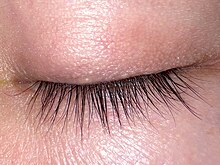FGF5
Ensembl | |||||||||
|---|---|---|---|---|---|---|---|---|---|
| UniProt | |||||||||
| RefSeq (mRNA) | |||||||||
| RefSeq (protein) | |||||||||
| Location (UCSC) | Chr 4: 80.27 – 80.34 Mb | Chr 5: 98.4 – 98.42 Mb | |||||||
| PubMed search | [3] | [4] | |||||||
| View/Edit Human | View/Edit Mouse |
Fibroblast growth factor 5 is a protein that in humans is encoded by the FGF5 gene.
The majority of FGF family members are
Receptor
FGF5 is a 268 amino acid, 29.1 kDa protein, which also naturally occurs as a 123 amino acid isoform
Role in hair cycling

The only described function of FGF5 in adults is in the regulation of the
In numerous genetic studies of long haired phenotypes of animals it has been shown that small changes in the FGF5 gene can disrupt its expression, leading to an increase in the length of the
It has been hypothesised that, in an alternate type of mutation, positive selection for increased expression of the FGF5 protein was one of the contributing factors in the evolutionary loss of hair in cetaceans as they transitioned from the terrestrial to the aquatic environment.[21]

FGF5 also affects the hair cycle in humans. Individuals with mutations in FGF5 exhibit
Blocking FGF5 in the human scalp extends the hair cycle, resulting in less hair fall, faster hair growth rate and increased hair growth.
References
- ^ a b c GRCh38: Ensembl release 89: ENSG00000138675 – Ensembl, May 2017
- ^ a b c GRCm38: Ensembl release 89: ENSMUSG00000029337 – Ensembl, May 2017
- ^ "Human PubMed Reference:". National Center for Biotechnology Information, U.S. National Library of Medicine.
- ^ "Mouse PubMed Reference:". National Center for Biotechnology Information, U.S. National Library of Medicine.
- PMID 25772309.
- ^ PMID 9856803.
- ^ PMID 10692103.
- ^ PMID 8901049.
- ^ PMID 11779149.
- PMID 26390813.
- ^ PMID 24989505.
- ^ S2CID 44491318.
- PMID 17433015.
- PMID 17767004.
- PMID 23384345.
- PMID 16879338.
- PMID 18779133.
- PMID 25927731.
- PMID 19273426.
- PMID 27755602.
- PMID 23394579.
- PMID 28272467.
- ^ .
- ^ PMID 28280377.
Further reading
- Li K, Stewart DJ, Ward HJ (April 1999). "Technology evaluation: gene therapy (FGF-5), Vical". Current Opinion in Molecular Therapeutics. 1 (2): 260–5. PMID 11715949.
- Werner S, Roth WK, Bates B, Goldfarb M, Hofschneider PH (November 1991). "Fibroblast growth factor 5 proto-oncogene is expressed in normal human fibroblasts and induced by serum growth factors". Oncogene. 6 (11): 2137–44. PMID 1658709.
- Haub O, Drucker B, Goldfarb M (October 1990). "Expression of the murine fibroblast growth factor 5 gene in the adult central nervous system". Proceedings of the National Academy of Sciences of the United States of America. 87 (20): 8022–6. PMID 1700424.
- Bates B, Hardin J, Zhan X, Drickamer K, Goldfarb M (April 1991). "Biosynthesis of human fibroblast growth factor-5". Molecular and Cellular Biology. 11 (4): 1840–5. PMID 2005884.
- Hébert JM, Rosenquist T, Götz J, Martin GR (September 1994). "FGF5 as a regulator of the hair growth cycle: evidence from targeted and spontaneous mutations". Cell. 78 (6): 1017–25. S2CID 44491318.
- Li JJ, Huang YQ, Moscatelli D, Nicolaides A, Zhang WC, Friedman-Kien AE (October 1993). "Expression of fibroblast growth factors and their receptors in acquired immunodeficiency syndrome-associated Kaposi sarcoma tissue and derived cells". Cancer. 72 (7): 2253–9. PMID 8374885.
- Clements DA, Wang JK, Dionne CA, Goldfarb M (May 1993). "Activation of fibroblast growth factor (FGF) receptors by recombinant human FGF-5". Oncogene. 8 (5): 1311–6. PMID 8386828.
- Ornitz DM, Xu J, Colvin JS, McEwen DG, MacArthur CA, Coulier F, et al. (June 1996). "Receptor specificity of the fibroblast growth factor family". The Journal of Biological Chemistry. 271 (25): 15292–7. PMID 8663044.
- Kitaoka T, Morse LS, Schneeberger S, Ishigooka H, Hjelmeland LM (April 1997). "Expression of FGF5 in choroidal neovascular membranes associated with ARMD". Current Eye Research. 16 (4): 396–9. PMID 9134330.
- Schneeberger SA, Hjelmeland LM, Tucker RP, Morse LS (October 1997). "Vascular endothelial growth factor and fibroblast growth factor 5 are colocalized in vascular and avascular epiretinal membranes". American Journal of Ophthalmology. 124 (4): 447–54. PMID 9323936.
- Kornmann M, Ishiwata T, Beger HG, Korc M (September 1997). "Fibroblast growth factor-5 stimulates mitogenic signaling and is overexpressed in human pancreatic cancer: evidence for autocrine and paracrine actions". Oncogene. 15 (12): 1417–24. S2CID 9261205.
- Ozawa K, Suzuki S, Asada M, Tomooka Y, Li AJ, Yoneda A, et al. (October 1998). "An alternatively spliced fibroblast growth factor (FGF)-5 mRNA is abundant in brain and translates into a partial agonist/antagonist for FGF-5 neurotrophic activity". The Journal of Biological Chemistry. 273 (44): 29262–71. PMID 9786939.
- de Vries CJ, van Achterberg TA, Horrevoets AJ, ten Cate JW, Pannekoek H (August 2000). "Differential display identification of 40 genes with altered expression in activated human smooth muscle cells. Local expression in atherosclerotic lesions of smags, smooth muscle activation-specific genes". The Journal of Biological Chemistry. 275 (31): 23939–47. PMID 10823842.
- Hanada K, Perry-Lalley DM, Ohnmacht GA, Bettinotti MP, Yang JC (July 2001). "Identification of fibroblast growth factor-5 as an overexpressed antigen in multiple human adenocarcinomas". Cancer Research. 61 (14): 5511–6. PMID 11454700.
- Kornmann M, Lopez ME, Beger HG, Korc M (2002). "Expression of the IIIc variant of FGF receptor-1 confers mitogenic responsiveness to heparin and FGF-5 in TAKA-1 pancreatic ductal cells". International Journal of Pancreatology. 29 (2): 85–92. S2CID 25093220.
- Sieuwerts AM, Martens JW, Dorssers LC, Klijn JG, Foekens JA (April 2002). "Differential effects of fibroblast growth factors on expression of genes of the plasminogen activator and insulin-like growth factor systems by human breast fibroblasts". Thrombosis and Haemostasis. 87 (4): 674–83. S2CID 13862591.
